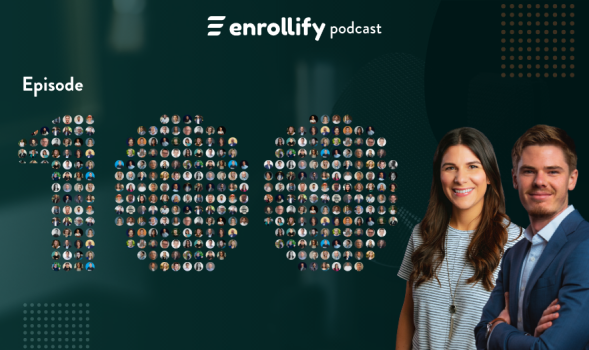Over the last 18 months, I’ve been fortunate enough to interview more than 100 leaders in enrollment marketing on The Enrollify Podcast.
From VPs of Enrollment Management to Directors of Marketing, from college presidents to famous SEOs, and from CEOs of EdTech companies to brand experts at education marketing agencies.
I have learned so much through the conversations that writing a recap post seems near impossible.
So, I’ve done my best to package 100+ hours of conversation into 10 learnings that have changed the way that I approach marketing. If you find this reflection helpful, I’d love to hear from you on LinkedIn.
Oh, and I also sat down with Enrollify’s Director of Marketing Strategy, Natalie Gleason, to be interviewed — for the very first time — on The Enrollify Podcast. You can listen to our conversation here.
Alright, onward!
1. Stop Asking Broad Questions and Expecting Meaningful Insight
I recently went back and listened to the first podcast interview I ever did…it was an embarrassing, humbling, and “please turn it off now” kind of experience.
Excusing the poor audio quality, the real gut-wrencher was the questions I asked the interviewee. They were the classic questions you’d expect from any interview-style show:
- What do you do?
- How do you approach your enrollment marketing strategy?
- What advice do you have for our listeners?
You get the gist.
The problem with these questions is that they are too broad to inspire an interesting or meaningful response from the interviewee. And I think this is important to remember when ascertaining student testimonials, prospective student feedback, or any other insight you are trying to garner that might shake up your current marketing mix.
Here are a few better questions that I’ve asked guests on recent podcasts:
- What’s something that’s not on your LinkedIn profile that you’re especially proud of accomplishing over the course of your career?
- Can you walk us through an “oh shit” moment? A time when you really thought this idea might go nowhere/might crash and burn? What was happening and how did you champion through the doubt?
- If I were to be invited to your household for a family dinner, and if I were to ask your close family and friends to describe you with three adjectives, what do you think they would say?
Dig deeper in your inquiry — meaningful insight lives in specificity.
2. Copywriting is the Most Accessible, Affordable, and Underrated of Marketing Tactics
I haven’t met a single higher ed marketer or admissions professional who has told me they have more resources than they know what to do with. In fact, almost every practitioner I have had on the Enrollify podcast (and across all of our network of shows) has said the opposite.
Neil Patel shares that 8 out of 10 searchers will read headline copy before clicking a post, but only 2 out of 10 will actually read the post. That means that your headline is critical for grabbing attention and keeping it.
You may not be able to outspend your competition on PPC, you may not have the resources to create zillions of content pieces around targeted keywords and topic clusters to increase your SEO, but you do have power over your words.
You do have influence over what headline is used on your Virtual Campus Visit Day landing page and the title text associated with your inquiry form, and the subject lines and preview texts you use in your communication flows.
All this is to say that when your product, which in this case is your program, your brand, or your campus offerings isn’t particularly unique, the way you get ahead, the way you stand out is by offering a sales experience around that product that is different from the rest of the pack.
And that difference in experience starts with your website…it starts with your social channels…it starts with your search emails, etc. It starts with excellent copywriting.
3. Imitate First, Differentiate Second
The problem for most brands is that they strive for differentiation too soon. A brand’s unique value propositions are its lifeline; its equity. But for most schools, the journey to differentiation should start with imitation.
It should start by carefully studying the best in the space, unpacking the elements that have made that brand a winner, and then implementing similar strategies in an attempt to realize a similar result.
If this is too hard to do within higher education, then look outside of the industry. The same basic frameworks that SaaS marketers use to convince a CTO to buy a $30,000 piece of enterprise software can be used by enrollment marketers to convince a high school student to buy a $30,000 education, even if the mechanics are different.
Study the copy they use, dissect their email comm flows, make detailed notes of the creative they use in their paid social campaigns using Facebook Ads Library, have a look at the keywords they are organically winning on using SEMrush.
Now you know what’s inside the box, it’s time to think outside the box — and this is where differentiation starts.
Listen to The Enrollify Podcast’s 100th episode for a deeper dive into these insights!
4. Measure Twice, Cut Once
My grandfather was an engineer. He had a small woodshed in his backyard where you could find him most evenings tinkering with the latest stool, frame, or bunk bed he was building.
His grandchildren loved working in Grandpa’s shed — and he was kind enough to “help us” build a couple of dog houses and bird feeders over the years. As if he was a broken record, he’d say “Zach, remember — make sure you measure again before you cut. Measure twice, cut once!”
While my grandfather did not pass along his woodworking gene to me, this idea of taking a second look, or even just another hour, to think before doing has stuck with me.
When it comes to marketing, intentionality is everything. Measurability is an expectation, not a luxury as it can be in brand advertising. Why are you doing what you are doing? How will you measure success? What will you learn from this experiment? What insight will you garner from this campaign that can be applied to future campaigns?
What I love about this principle is that the ratio from planning to execution is 2:1…not 3:1, or 5:1, or 10:1…planning is remarkably important, but too much of it can kill an idea before it has a chance to fight — especially in an environment like ours that is constantly changing.
5. The Future of Brand is Casual
The advent of direct-to-consumer products have inspired a monumental shift in how brands position themselves. In years past, the retailer was the middleman — they were the ones responsible for creating a delightful customer experience.
The Dollar Shave Club’s, Allbirds’, and Warby Parker’s of the world, have set a new kind of precedent for brand messaging that feels more relatable and less aspirational.
These brands have pivoted from the traditional “here’s why you should buy these glasses” to “who wouldn’t want to try on 5+ unique pairs of glasses from the comfort of their home?” approach.
Next generations are skeptical of frou-frou messaging and gaudy positioning — they’ll take a “what’s up, Zach?” over “Dear Zachary,” any day.
Colleges and universities looking to differentiate themselves need look no further than their lead gen pages and ask themselves (or better yet, their favorite 17-year-old), would this page compel you to give up your email address or phone number?
6. “How to” Content Still Really Freakin’ Works
60% of Enrollify’s top 25 podcasts of all time start with, “How To”.
It’s one of the oldest tricks in the bag, but if you’re looking for the quick hack in this article, this is it.
“How to” titles and headlines compel views, streams, and listens.
Enough said.
7. Marketing Attribution is Still Subjective—And That’s Not Necessarily a Bad Thing
Understanding a prospective student’s journey from Google Ad click to enrolled student has never been easier.
There are an incredible number of tools and technologies available today — such as HubSpot and Element451 — to help enrollment marketers understand the digital footprint of their school’s inquiries, applicants, and students.
And yet, schools still struggle to develop systems that assign appropriate credit to each action a student takes on their path to enrollment.
While marketing attribution is incredibly important to help schools understand where to invest more time, more money, and more talent, there’s no one standard or playbook that all must follow.
Rather, the schools slaying the attribution game, have assigned a particular value to each action a prospective student takes — 5 points for a Google Ad click, 10 points for a visit from organic search, 15 points for an email click, 25 points for a phone call, etc.
Think of this as akin to lead scoring, but rather than these metrics being used to assess lead value, they are being used, retroactively, to divvy out credit to a specific strategy, channel, or tactic.
It’s not an objective “marketing gets credit for inquiries” and “admissions gets credit for enrolled students” situation…but rather an approach that helps enrollment marketers understand the recipe that yields the greatest ROI.
8. 80% of Your Content Can Be Good if 20% of Your Content is Great
Good, consistent content is more important than great, inconsistent content.
Folks will argue with me on this one, but I think most brands that pou-pou content marketing do so because they struggle more with consistency than they do with quality content.
One, impeccably well-written, 2,500+ word blog article is just not going to boost your SEO as quickly as five, pretty-good, 500 word articles will.
Listen to The Enrollify Podcast’s 100th episode for a deeper dive into these insights!
Beyond the SEO play, when you publish inconsistently, you’re banking on the quarterly piece being a slam dunk, getting shared all over social media, and generating noteworthy feedback. And in my experience, this is a gamble that, 9 times out of 10, just isn’t worth taking.
Now, you still need great, share-worthy, attention-holding content…but as long as a piece that really challenges your audience to think differently or inspires them to try something new shows up 20% of the time, you’re in great shape.
Also, keep in mind that “good” is still “good”…it is NOT “poor.”
9. Insert Yourself Into the Conversation
Conversational marketing is one of the hottest trends in marketing today because it best emulates the way consumers actually make purchasing decisions.
The framework as made famous by Drift and contextualized for higher ed by our friends at Mongoose is simple: engage, understand, and recommend. In higher ed, we’re great at the “engage” and “recommend” steps, but not so much at the “understand” step.
Prospective students buy the promise of an experience and a specific outcome from higher education.
And in an effort to be uber-personalized in our communications, I think we’ve lost one of the most important aspects of personalization — the other “1” in 1:1 communication, the enrollment manager!
Marketers and admissions professionals should splice their unique experiences, insight, and “why” into conversations with prospects.
Not only does it produce a more authentic sales experience, but will more quickly unearth any points of friction or concern that might otherwise go unnoticed.
10. Higher Ed Marketers are More Progressive Than You Think
Every enrollment manager I have ever met has said something along the lines of “if we can just get them to campus, we can get them to apply!”
COVID-19 threw a massive wrench in this idea when 95% of schools shut down in-person recruitment events for the better part of a year and forced schools to have “Come to Jesus” conversations about their digital experiences.
And yet, I was amazed to hear stories of schools successfully pivoting.
Marketing and admissions worked together to quickly sign on with Unibuddy or PlatformQEducation to run their virtual information sessions. Schools looked to DD Studio and GoodKind to tell stories and offer clarity through compelling video.
Questions shifted from “should we advertise on YouTube” to “What YouTube Advertising strategy makes the most sense for our school?”
Folks got creative. Teams got scrappy. And they advanced an industry that is stereotyped as complacent, bureaucratic, and resistant to change by 5 to 10 years.
And of all my learnings, this might be the most important — that is to not underestimate the value proposition of higher ed (even though it may need some spring cleaning) nor the enrollment marketers behind it.
You see, higher ed marketers and admissions professionals are more often than not eager to believe in an idea, an approach, or a strategy that might be working outside of the industry and find a way to make it work for student recruitment — the friction is often tied up in resources or buy-in from leadership.
In the last 18 months, I’ve seen silos between admissions, marketing, and student success broken down; I’ve seen presidents ask heads of marketing what they can do to better support their initiatives; I’ve seen a genuine willingness to test out a new campaign idea or a new suite of marketing automation tools.
And my hope is that as we move into a post-pandemic world, this posture doesn’t change.
Over these next 18 months, Enrollify will continue to be a place of intersection where higher ed marketers and admissions professionals come to learn new marketing skills and discover new software and services.
It will soon also be the place where enrollment marketers network with the best minds and find their next gig.
But as we evolve, one thing will always remain the same — our commitment to helping you optimize the resources you do have to generate the results you need.
Cheers to the next 100 podcasts!
Read more here…


![[AWARDS] Why We Created The Brilliance Awards (Hint: You)](https://www.schoolhouse.agency/wp-content/uploads/2021/08/AWARDS-Why-We-Created-the-Brilliance-Awards-Hint-You-1024x683.jpeg)


